Standing in the backyard of her sweeping 20-hectare mountain property, in Kinglake, Victoria, Jemima Richards stares over the treestops towards Melbourne’s skyline.
From this spectacular spot, an hour from the city, the smell of eucalyptus rises from forests where bellbirds sing again and where affordable house prices have brought a steady influx of new families into this pretty bush community.
On the surface Kinglake is like any other close-knit rural township where neighbours run into each other at the local shops or at the footie, their daily lives intertwining in the way they always do in small country towns.
Despite its apparent normality, however, Kinglake remains a town in recovery, the charred stumps of burned-out gums peering starkly from leafy bush tracks, a haunting reminder of the fateful day that life changed forever.
It is what Jemima describes as the ‘new normal’, the sort of normal that follows any catastrophe where an invisible line is etched in trauma, forever defining the old life from the new, the ‘before’ from the ‘after’.
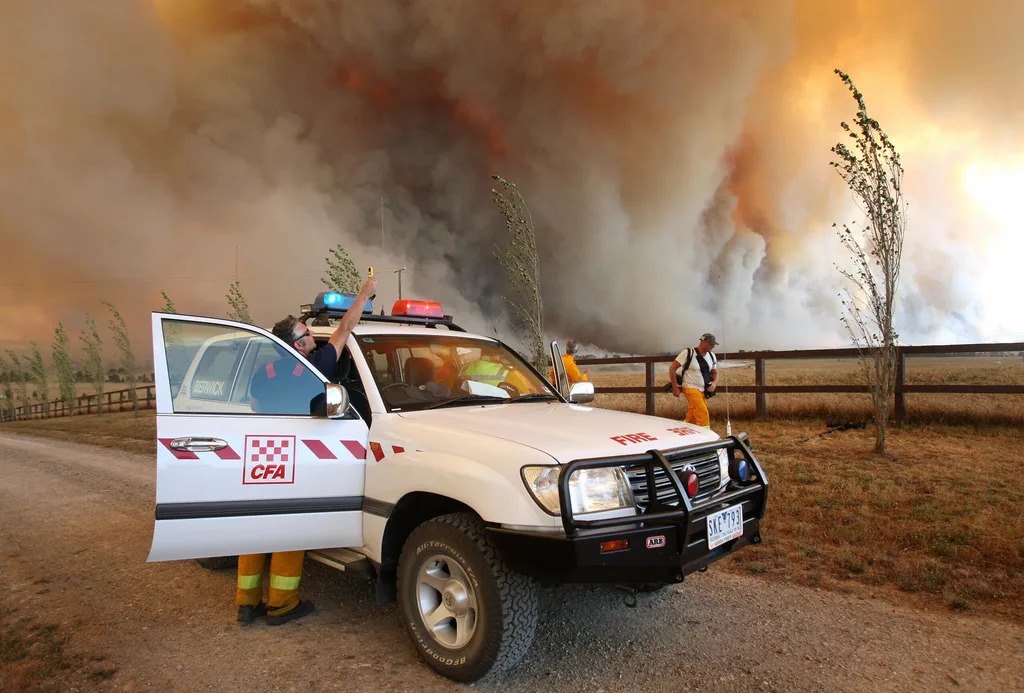
CFA members monitor a raging fire near Labertouche, Victoria. (Image: Getty)
For Kinglake, that defining line was drawn in hot embers on Saturday, February 7, 2009, when the hottest day Victoria had ever known sparked the deadliest, most intense firestorm in Australia’s post-European history.
Today, 10 years after the inferno that claimed 173 lives and destroyed more than 2000 homes, The Weekly examines the dark legacy of the Black Saturday fires which, for some, has burned scars so deep they will never heal.
Saturday, February 7, opened to blistering skies. Seven years of drought and a week-long heatwave had left Victorians bracing themselves for the worst fire day in the State’s history.
The previous afternoon, tinder-dry conditions and predicted hot north-westerly winds had sparked the mobilisation of 358 firefighters into Victoria’s bush communities, from Horsham in the north to East Gippsland, where a deliberately lit fire had already destroyed dozens of homes.
Battling that blaze, Country Fire Authority (CFA) volunteer David Tree paused to share a bottle of water with a dehydrated koala. His act of compassion was captured by firefighter, Mark Pardew, whose iconic image went viral, becoming the human face of the worst bushfires since 1788.
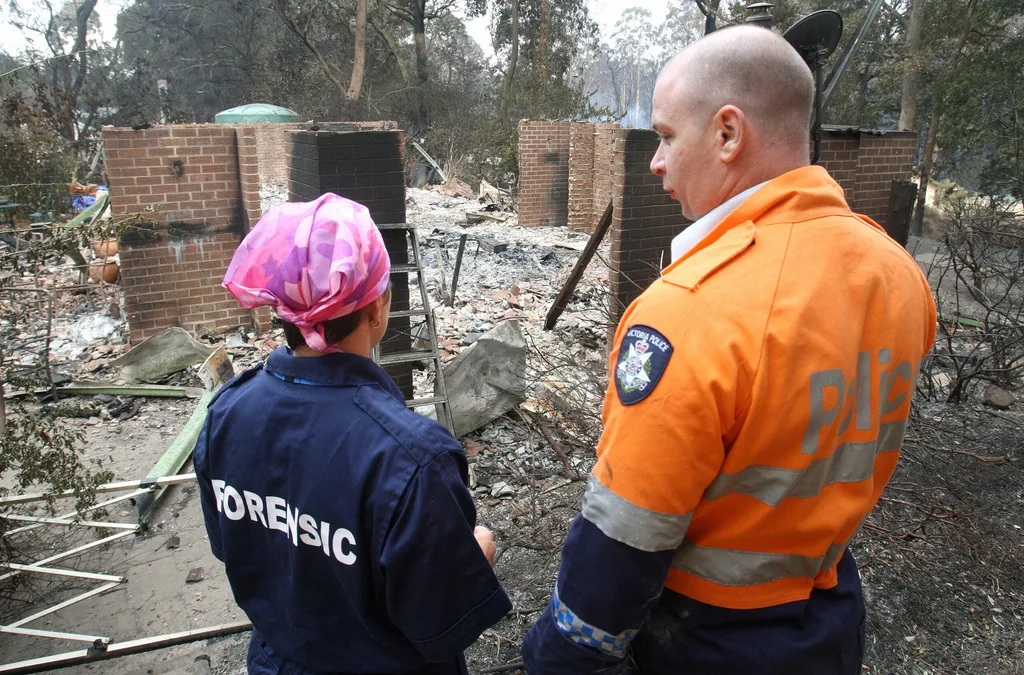
Police oversee a house destroyed in Kinglake, Victoria. (Image: Getty)
On that Saturday morning, people were up early in Victoria, cranking up their air-conditioners and running their errands, unaware that a fire in the Bunyip State Park had already jumped containment lines or that, within hours, hundreds more would be burning around the state.
At 8am, as Jemima drove from Kinglake to her beauty salon in suburban Kew, another local, Rebecca Buchanan, was busy at the Whittlesea showgrounds, preparing for the annual community music festival. Rebecca’s son Callum, 18, was filling in for her at the local hardware store in Kinglake West.
At midday, escalating winds brought down the powerlines in Kilmore East, sparking a ferocious blaze which, fanned by high winds and record-breaking temperatures of 46.4C, tore towards Whittlesea, growing into the deadly firestorm.
From the crowded showground, Rebecca anxiously watched thick smoke turn into flames, change direction with the wind and race up the mountain towards her home.
It was 3pm. Panicking, she rang her husband Ross, urging him to take their sons Mackenzie, 15, and Aiden, 13, to her parents’ place in Pheasant Creek, where their daughter Neeve, nine, had stayed overnight. The children would be safer there while Ross put their fire plan into action at home.
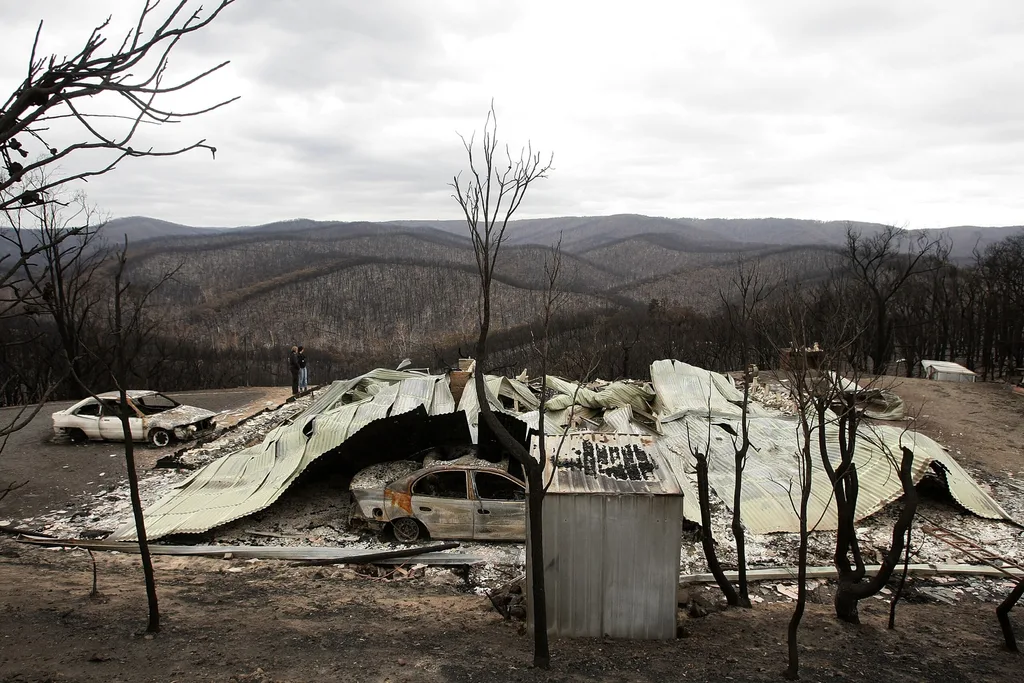
A family inspect their property in Steels Creek, Victoria. (Image: Getty)
That afternoon, two other concerned parents, CFA volunteers David and Carol Matthews, also telephoned home, telling their children Sam, 22, and Ellie, 19, that they were returning to St Andrews because of the fires. Ellie was on her way to work at Nando’s in Melbourne, but Sam, also a CFA volunteer, insisted things were under control. The fires were nowhere near St Andrews, he said.
At 5pm, Jemima’s husband, David Exton, called her at work. “Don’t come home, there’s smoke everywhere,” he warned, but reassured her that the fires were “miles away”.
He had barely hung up when the firestorm roared through Kinglake and Pheasant Creek, claiming the lives of countless locals.
Rebecca’s parents, Mick and Jenny Clark, realising that Aiden had made it safely out behind them, fought desperately to rescue Mackenzie and Neeve. Jenny sustained such serious burns that she spent days in a coma, but her grandchildren Neeve and Mackenzie perished with their uncle Danny Clark, 35, as they fled the blazing home.
Miraculously, Rebecca’s son Callum escaped from Kinglake, driving through the flames with a friend. Meanwhile, in St Andrews, Sam Matthews was on the phone to his mother when the fire struck.
“What’s that noise?” asked Carol, alarmed to hear loud popping down the phone.
“The windows are exploding … there’s fire everywhere,” he replied.
It was the last time Carol would ever hear her son’s voice.
WATCH NOW: Farmers fight to save their property during 2009 Black Saturday Bushfires
The fires were still raging when David called Jemima again, breaking the news that their home had gone, along with his brother Tony’s and their parents’ property. The entire town was on fire.
“It’s hard to breathe,” he gasped. “We’re in the dam at the back of Tony’s place.”
Then the phone died.
For seven harrowing hours, all contact was lost, the TV updates later revealing Marysville had been hit by another blaze which had broken out in Murrindindi and raced through Narbethong, claiming more lives and homes.
When David finally made contact, saying his family was safe, he told Jemima: “You’re not going to believe this, but our house is still there and about 50 people have taken refuge in it. Those who are not burned are fighting to save it,” she recalls.
The fires were still blazing two days later when Jemima finally made it home to a world that resembled an apocalypse, with debris smouldering where homes had once stood.
“It was like a war zone, full of death and destruction, the air thick with horrid smells,” says Jemima. “There were two colours in my world that day – black and grey. And when I finally looked into Dave’s eyes, it was as if there was no one home. Everyone lost something that day – and some lost everything.”
A map outlines the total number of devastating deaths as a result of the bushfires. (Image: Supplied)
In the dark days that followed, the property became a haven to many more. Caravans for the homeless scattered the paddocks and a giant army tent hosted the volunteers.
Lines of refrigerated shipping containers arrived for the storage of vital food supplies for the community kitchen, which was soon feeding hundreds.
Help poured in from everywhere, from the wealthy entrepreneur who donated money to the recovery to the bikie who rode his Harley down from Queensland to lend a hand.
Ro Allen and Kaye Bradshaw arrived in the UnitingCare Cutting Edge bus, which became an office and internet link to the outside world. When an official relief centre opened, the two women stayed on to help.
“We were feeding 200 people a night, and when government officials arrived to take over, saying they were closing us down, we refused to stop what we were doing because people had formed a connection and were drawing strength from each other,” says Jemima.
Communal meals became times for sharing, allowing survivors to process the horrors. “It became obvious that men and women were coping differently and that, while women wanted to talk about their experiences, their partners couldn’t,” explains Jemima.
As weeks passed, many showed signs of post-traumatic stress, surfacing in depression, alcohol and substance abuse, anger and family violence. Tired of hearing people saying things would soon get back to normal, Jemima and her friend Kate Riddell founded a support network to raise morale, help families begin the recovery process and help women create a new ‘normal’.
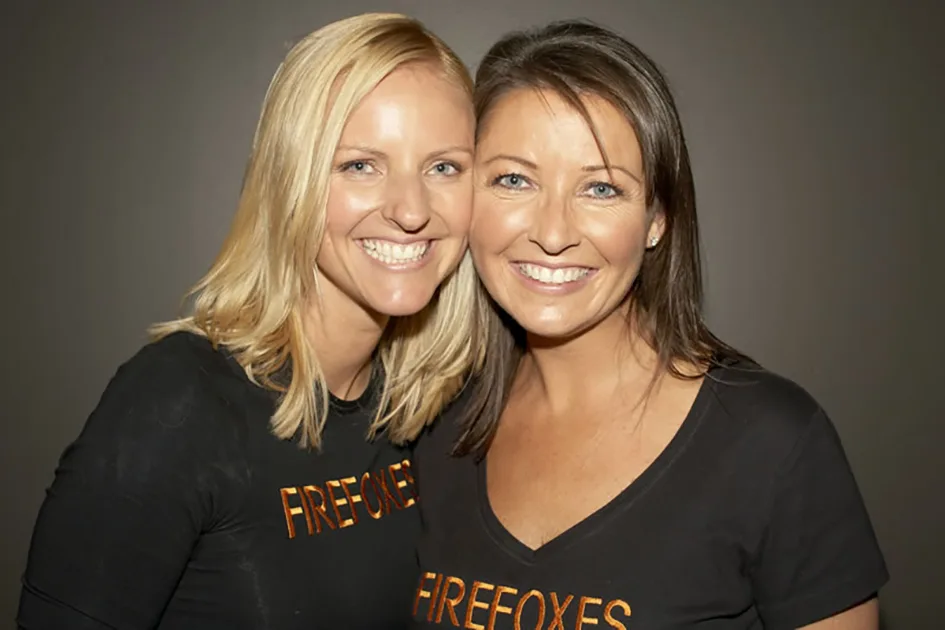
Firefoxes founders Kate Riddell and Jemima Richards.(Image: Supplied)
Over lunches and gatherings, Firefoxes was born, and stories were shared that identified the changing needs of the stricken community.
When former Westpac CEO Gail Kelly heard Jemima speak about the role the organisation was playing in the bushfire recovery effort, the bank threw itself behind the initiative and Firefoxes became a future model for other communities recovering after disaster.
In 2011, Firefoxes flew into the Queensland floods to share lessons learned from Black Saturday, and they returned when a cyclone hit North Queensland, supporting other women whose families had lost everything.
“From Black Saturday we learned that, when disaster strikes, whether it’s fire, flood or cyclones, life is never the same again, and people go through a similar process of shock, grief, anger and despair, which affects all aspects of their lives, including their connection to their wider community,” says Jemima.
Government-appointed bushfire trauma expert Professor Rob Gordon agrees, explaining there is often a disconnection in the survivors of tragedies, which leaves them feeling disengaged. “After surviving the initial trauma of Black Saturday, people found themselves displaced, homeless and unable to work, which created a state of perpetual crisis.
Many survivors felt anxious about their immediate safety or afraid about the future, and some saw no point in anything anymore.”
Carol Matthews was plunged into that dark place. “When you don’t feel safe in your own home, how can you ever feel safe anywhere again?” she asks.
“After Sam died, I didn’t know where I belonged anymore and we moved nine times, unable to settle while Sam’s body had yet to be released.”
When the call finally came, it unleashed a new anger in Carol and in her traumatised daughter, who had been at work when the fire struck their home.

A for sale sign stands alone on a blackened property in Kinglake, six months after the Black Saturday bushfires. (Image: Getty)
“Because everything had gone, there was nothing left to draw comfort from – no photographs of Sam or memories of our old lives,” says Carol, 58. “All Ellie had left of her old life was the Nando’s uniform she’d worn to work that day.
She was living someone else’s life in someone else’s bedroom surrounded by their things, and was so angry I’m certain if she’d had her own room she’d have smashed everything in it.”
Like the Matthews family, many survivors were stuck in a limbo of grief, which for some proved too much. In 2012, four suicides in a single month prompted a crisis meeting in Kinglake to address the escalating situation.
Among the casualties were a paramedic who had helped recover the dead and a local man whose pre-existing trauma had been compounded by Black Saturday. His father later said it had been “one bad thing too many”.
While new buildings rose from the ashes, thanks to the $20.5 million raised by the bushfire appeal, the suffering continued to impede the psychological and social recovery of towns like Kinglake, where grief turned to anger.
In Gippsland, that anger found a focus after David Tree’s iconic image was broadcast on the Ellen DeGeneres show, his community branding him a publicity seeker and nicknaming him Captain Chlamydia.
“People thought I was making a fortune from that photo, even though I hadn’t taken it, and though it later raised thousands for the Red Cross Bushfire Appeal,” recalls David, 54, who 10 years on is still a CFA volunteer. “But for me, it captured what the CFA is all about – saving lives, property and everything in between.”
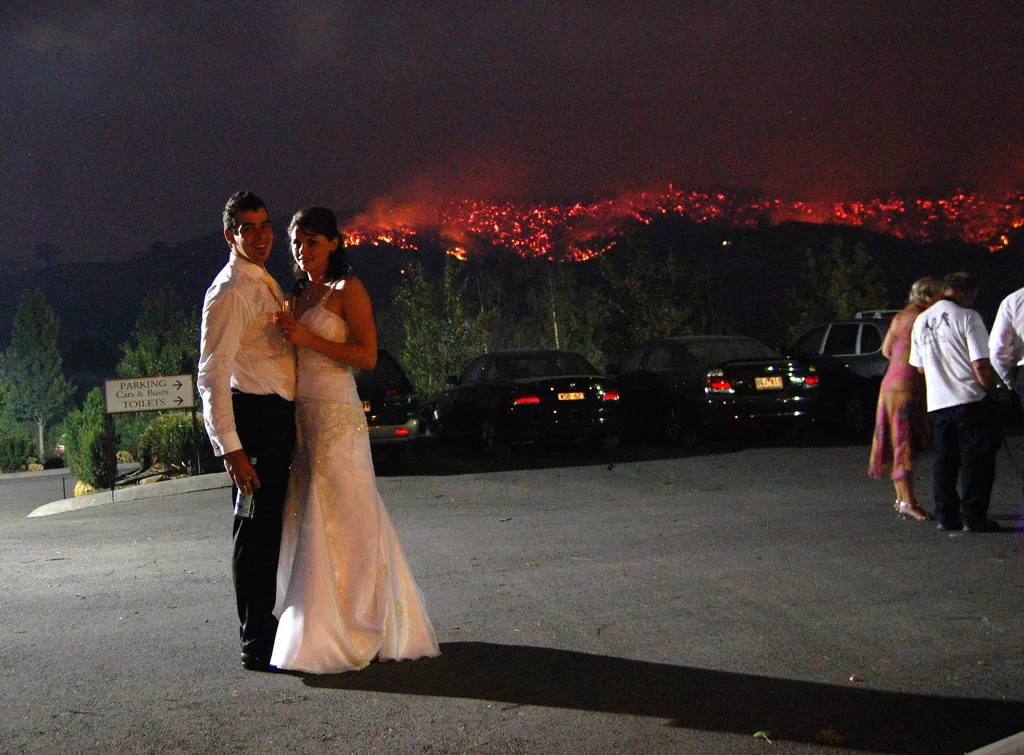
Ben and Liz van Deventer’s wedding was taking place when the fire swept in, and staff battled to save the venue. (Image: Supplied)
In 2013, 10,000 claimants – many suffering PTSD and illnesses like cancer stemming from the fires – joined Victoria’s largest civil claim, suing AP Ausnet, the company that owned and operated powerlines that caused the Kilmore East fires.
Its contractors, the CFA, Victoria Police and Department of Sustainability were joined in the action, which settled when the Victorian Supreme Court ordered almost $5 million in compensation paid to Black Saturday victims. In a second class action brought by survivors of the Murrindindi fire, 1100 claimants, mostly from Marysville, received $4 million in compensation.
Now, as Australia pauses to remember, Carol Matthews is hoping something positive will come from her son’s death, and is pioneering a new initiative to save lives and spare future families the suffering hers has endured.
With a $250,000 government grant, she has designed and built a specially equipped bus, emblazoned with “What Will You Do In the Heat of the Moment?”, and created an immersive audio-visual experience. As we go to press, she needs another $50,000 so that the bus can hit the road this fire season.
“We train CFA recruits and the public to physically prepare for bushfires, but this immersive bushfire experience emotionally prepares people, so when the power goes off, the sirens blare and windows explode, they don’t panic – they know what to do,” says Carol.
For most, the 10th anniversary of the fires will be a time for quiet reflection, to remember those who lost their lives. Melbourne couple Ben and Liz van Deventer, who married that day at the De Bertoli Winery, will also remember the staff and band battling to save the venue.
“It’s a day we won’t forget though it always felt disrespectful to celebrate on a day so many lost so much, so we don’t really talk about our wedding day,” says Liz, now the mother of two boys. “We have been back with our children, and always feel blessed. We were very lucky that day. We never forget that.”


